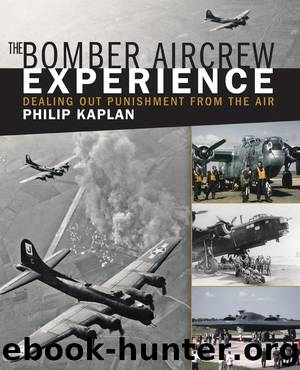The Bomber Aircrew Experience by Philip Kaplan

Author:Philip Kaplan
Language: eng
Format: epub
Publisher: Skyhorse Publishing
Published: 2016-04-19T16:00:00+00:00
Administering a transfusion under the wing of an 8AF bomber;
“I braked hard and had Tom pull the drag chute; we stopped in 7,000 feet. I immediately cut the eight engines and rang the bell to evacuate the airplane. I was out of my harness and behind Tom as we jumped down the ladder and out of the bottom of the plane, where the fire was burning real well. We ran ahead of the airplane and off the left wing to our crew assembly point in case of a crash-landing.
“The crash crew arrived with their foam and hoses. They had to go into the bomb bay to squirt foam up into the alternator deck. It took them thirty minutes to get the fire under control and put out all of the smouldering tires. A crew bus picked us up and took us to the maintenance debriefing room. All the ‘wheels’ were there wanting to know what had happened. After cleaning up the foam, the maintenance inspectors looked at the Marmon clamps and saw what had happened. They wired SAC headquarters and Boeing in Seattle. All B-52s were promptly grounded until they had been inspected. A permanent fix was made and all of the clamps were changed. For us it had been a rather hair-raising experience.”
—Joseph Anastasia, B-52 pilot, U.S. Air Force
FATIGUE, n. Physical or mental weariness resulting from exertion.
“We would make runs in formation, on fictitious targets in England, get back to base, and make some instrument approaches and landings for hours—just touch the wheels down, give it the gun, go around, and come back for another. All the time there was something to do—work on your radio operator’s speed, your engineer’s know-how, there was always training to do. We carried a very high fatigue factor at that time. If I had five minutes in a chow line I could go to sleep standing up.”
—Lawrence Drew, B-17 pilot, 384th Bomb Group (H), Eighth USAAF
“I remember that period of forty hours in which I flew three ops. On 14 October 1944, Harmer, our pilot, was grounded with a cold. Flying Officer Lewis needed a bomb aimer, so I went along with him to Duisburg in daylight. I had just gone to bed when I was dragged out to go to Duisburg again with Lewis. Take-off at 00.39 on 15 October. It was a bad trip. We could see the target burning 100 miles away, from our morning attack. There were nightfighters around and we were nearly coned by searchlights over the target. I began to appreciate the talents of my own crew. So, I got back home, ate my bacon and eggs with sleepy eyes, and suddenly found that I was scheduled for another trip, with Harmer and my own crew, at 1800. I napped for a couple of hours in the mess, checked my bomb load, perspex, guns, circuits—check, check, check—dozed through the ops briefing, and took off for Wilhelmshaven. On the way home I could hardly keep my eyes open, but I was with my own crew so it didn’t really matter.
Download
This site does not store any files on its server. We only index and link to content provided by other sites. Please contact the content providers to delete copyright contents if any and email us, we'll remove relevant links or contents immediately.
| Africa | Americas |
| Arctic & Antarctica | Asia |
| Australia & Oceania | Europe |
| Middle East | Russia |
| United States | World |
| Ancient Civilizations | Military |
| Historical Study & Educational Resources |
The Radium Girls by Kate Moore(11616)
100 Deadly Skills by Clint Emerson(4683)
The Templars by Dan Jones(4556)
Rise and Kill First by Ronen Bergman(4542)
The Doomsday Machine by Daniel Ellsberg(4241)
The Rape of Nanking by Iris Chang(4019)
Killing England by Bill O'Reilly(3896)
Hitler in Los Angeles by Steven J. Ross(3796)
Stalin by Stephen Kotkin(3720)
12 Strong by Doug Stanton(3418)
Hitler's Monsters by Eric Kurlander(3161)
Blood and Sand by Alex Von Tunzelmann(3055)
Darkest Hour by Anthony McCarten(3017)
The Code Book by Simon Singh(2854)
The Art of War Visualized by Jessica Hagy(2835)
Hitler's Flying Saucers: A Guide to German Flying Discs of the Second World War by Stevens Henry(2621)
Babylon's Ark by Lawrence Anthony(2427)
The Second World Wars by Victor Davis Hanson(2419)
Tobruk by Peter Fitzsimons(2373)
